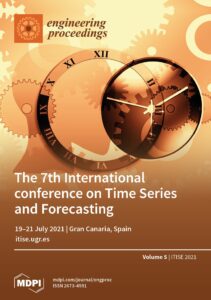 The article «Asymptotic Distributions of M-Estimates for Parameters of Multivariate Time Series with Strong Mixing Property» was published in «Engineering. Proceedings» and presented at the 7th International conference on Time Series and Forecasting, Gran Canaria, Spain, 19-21 July 2021. Authors – A. Kushnir and A. Varypaev.
The article «Asymptotic Distributions of M-Estimates for Parameters of Multivariate Time Series with Strong Mixing Property» was published in «Engineering. Proceedings» and presented at the 7th International conference on Time Series and Forecasting, Gran Canaria, Spain, 19-21 July 2021. Authors – A. Kushnir and A. Varypaev.
The paper investigates the asymptotic properties of statistical estimates for the vector parameter \mathbf{u} \in R^q of a multidimensional random time series z_{t} \in R^m , t \in \mathbb{Z} , satisfying the strong mixing conditions. The authors have considered estimates \widetilde{\mathbf{u}}_{n}(\overline{z}_{n}) that are solutions of the equations \bigtriangledown_{\mathbf{u}}Q_{n}(\overline{z}_{n};\mathbf{u}) = 0, \overline{z}_{n} = (z^T_{1},...,z^T_{n})^T, where Q_{n}(\overline{z}_n;\mathbf{u}) are some objective functions for which \bigtriangledown_{\mathbf{u}}Q_{n}(\overline{z}_{n};\mathbf{u}) satisfies some constraints. It was proved, that under these constraints, the estimates \widetilde{\mathbf{u}}(\overline{z}_{n}) are \sqrt{n} – consistent and asymptotically normal with a limit covariance matrix \mathbf{D(u) = \Phi^{-1}(u)\Psi(u)\Phi^{-1}(u)} uniquely determined by the objective functions Q_{n}(\overline{z}_{n};\mathbf{u}).
The results of this paper are a generalization of the methods for constructing and analyzing the asymptotic properties of M-estimates, which were previously studied for the case of independent identically distributed observations.
Source: Kushnir, A.; Varypaev, A. Asymptotic Distributions of M-Estimates for Parameters of Multivariate Time Series with Strong Mixing Property // Eng. Proc. 2021, 5, 19. 10.3390/engproc2021005019



